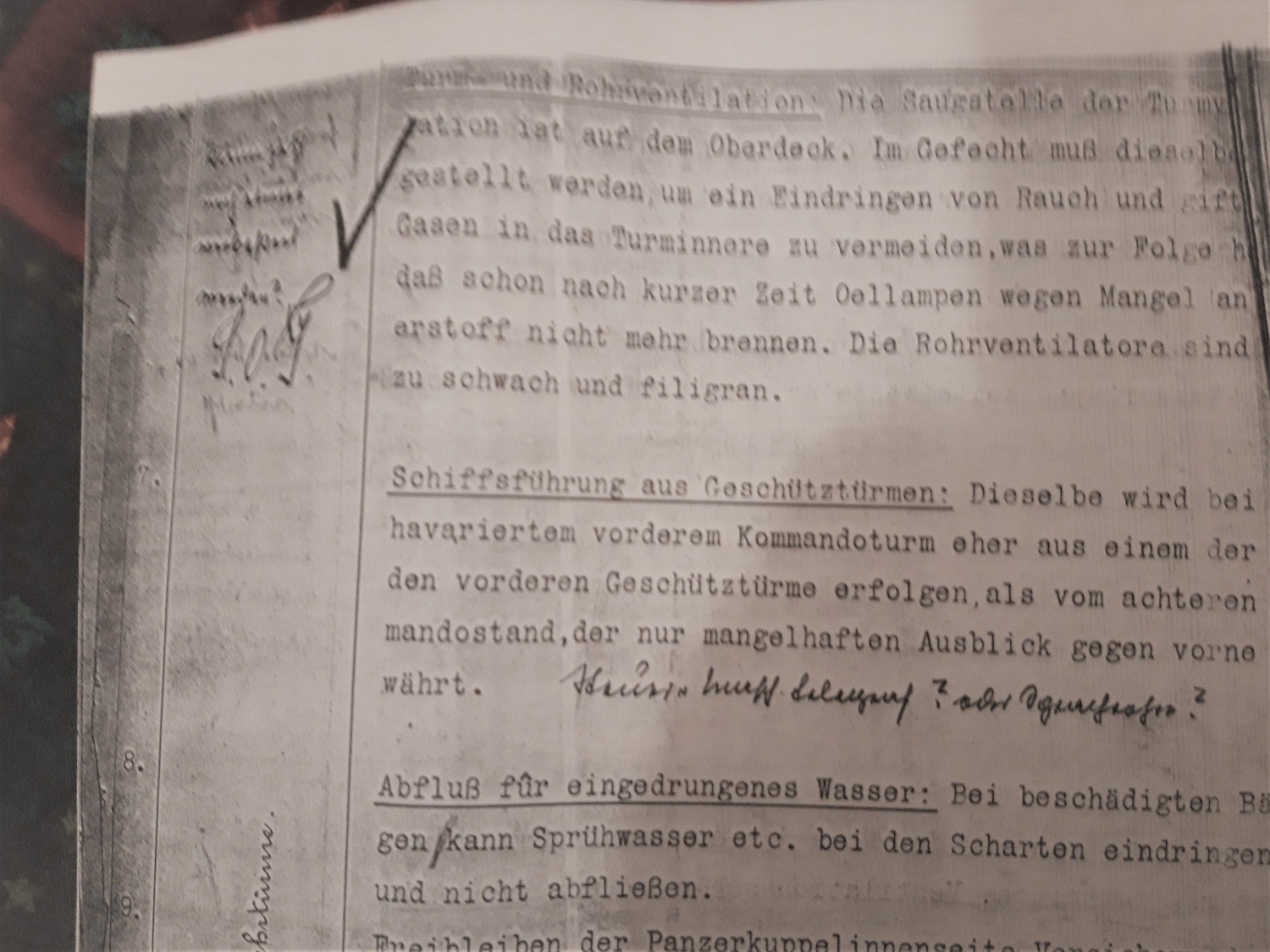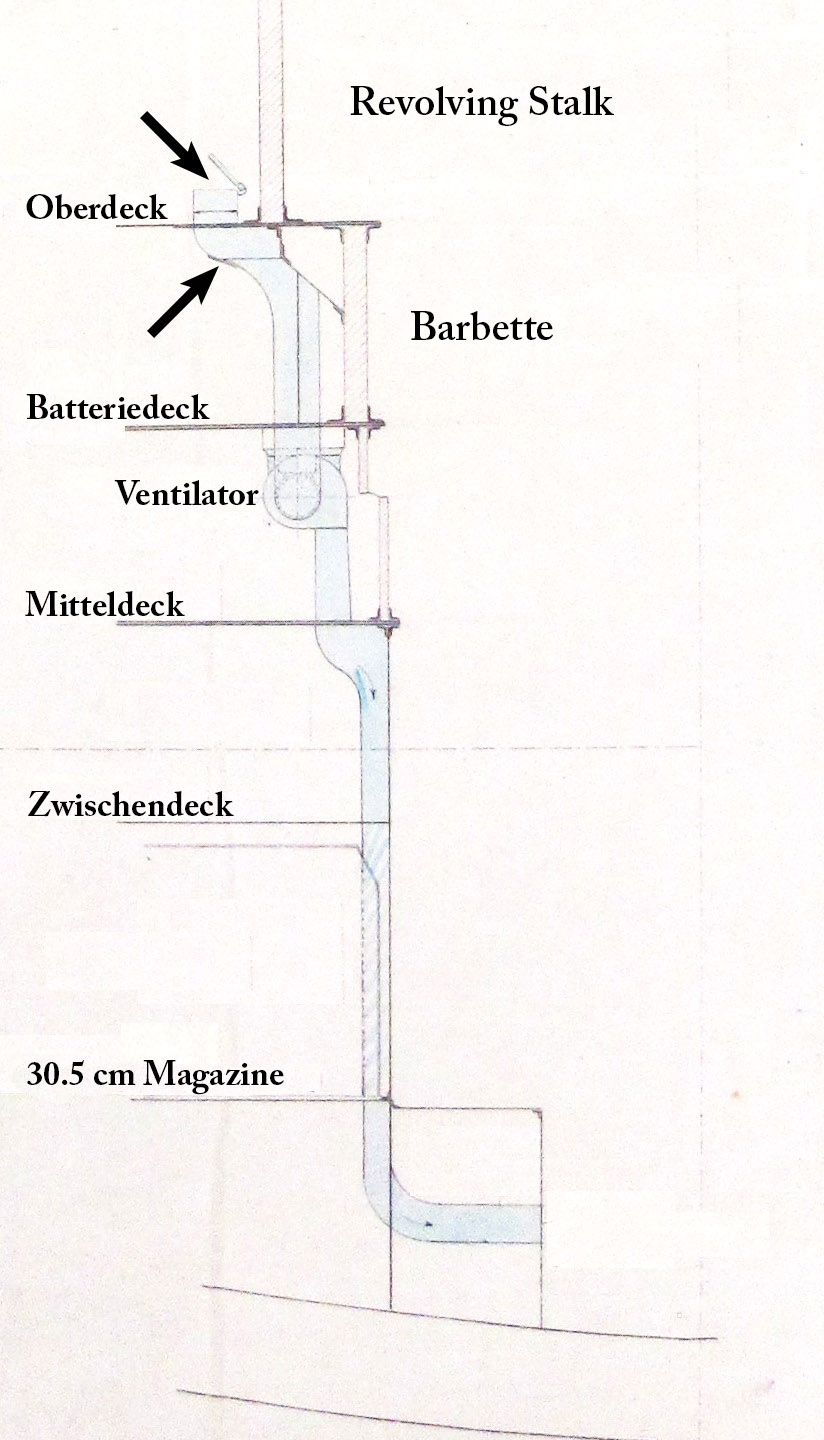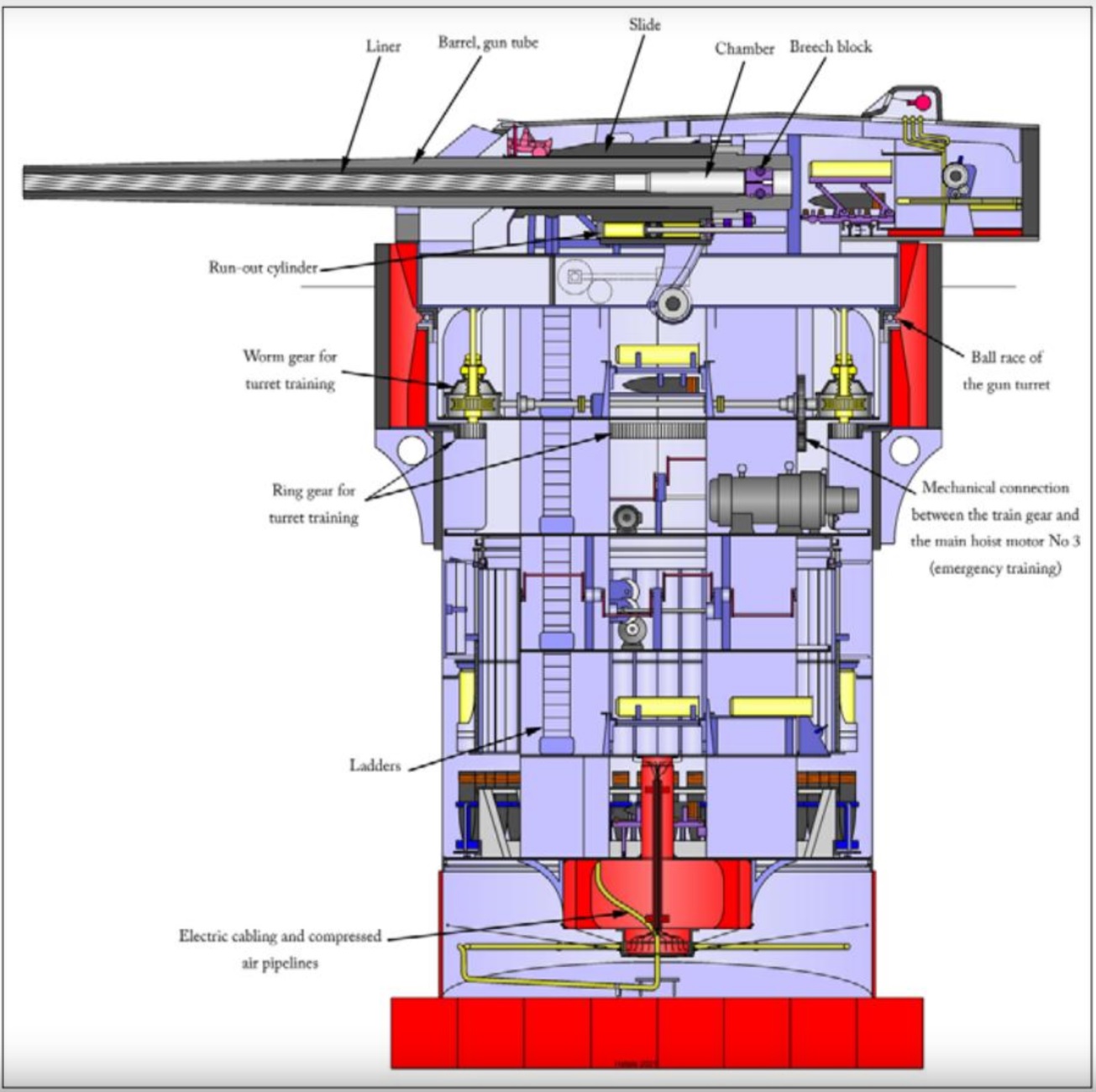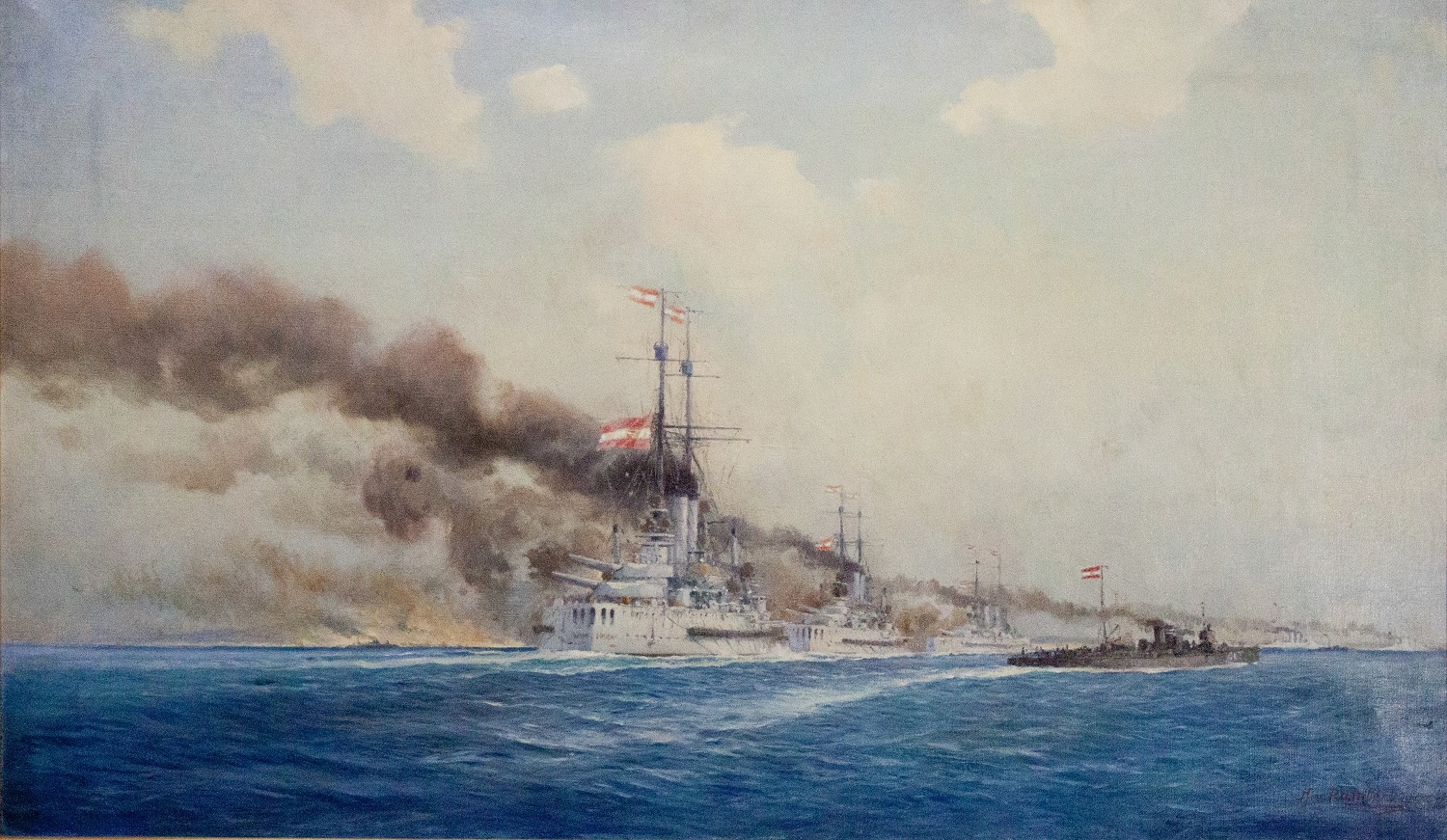This essay is an improved version from what was originally published in Hungarian on the Ars Militaria website as
"A Használhatatlan Lövegtornony Mítosza: Legenda Vagy Valóság?"
To Inhapi
In looking through websites on the internet, one would think that the gun turrets of the only Dreadnought-type battleships of the Austro-Hungarian Navy, the Tegetthoff class, were useless as well as being dangerous to their crews. Primarily this is because many of these websites state that, in a combat situation, the ventilation system for the turrets had to be shut down to avoid sucking in propellant gases and, as a result, the oxygen in the turret ran out in a quarter of an hour. Such a serious claim, if true, would mean that the four battleships which had cost the taxpayers of the Dual Monarchy a sum of 242.4 million Kronen – equivalent to 73 metric tons of gold – were not worth much more than a pile of junk.
The weight of the above statement is increased by the fact that it feeds not only from some fictitious sources but also from a real, official source. This was none other than a report about his ship written in 1916 at the request of the Navy by the commander of the Viribus Unitis, Linienschiffskapitän (Captain) Kamillo Teuschl. This began to spread in public consciousness after the publication of René Greger’s article "Who Was Responsible for the Faults of the Tegetthoff Class" in Warship Vol. IV, 1980, pp. 69–72. Over the years this statement of the report has been referred to in several scholarly or semi-scholarly works. What they have in common is that they repeat what is described in the report, but they make no attempt to investigate the matter further to ascertain its veracity.
This question has been a concern to me since I first saw it. After all, if one thinks about it, how can a navy afford a technical solution that degrades its latest battleships into expensive steam yachts. On the other hand, from the point of view of common sense, how could such a mistake have occurred when similar gun turrets had been designed and manufactured almost two decades earlier? These had been operating for more than a decade and a half on more than a dozen ships without such a problem. Should one believe that any navy would allow such a mistake in design or if it did, not take immediate steps to remedy it? However, there is always the possibility of an "exception." I would mention just one example of this: the Royal Navy had been aware of the defective quality of its large-caliber projectiles well before the First World War, yet they did nothing to remedy the problem until after the Battle of Jutland. I therefore believe that in the case of the Austro-Hungarian triple turrets it is worth an investigation, if not one requiring the skills of Sherlock Holmes, at least one needing the skills of Dr. Watson.
The first true gun turrets of the Austro-Hungarian Navy appeared on the Monarch class coastal defense ships in the mid-1890s. In these twin turrets were mounted the Navy’s first large-caliber Quick-Firing (QF) guns, the Krupp 24 cm/40 C/94. The 30.5 cm caliber was reintroduced to the Navy on the pre-dreadnought battleships or semi-dreadnoughts of the 14,500 ton Radetzky class, built between 1907 and 1911. The 30.5 cm/45 QF guns and their twin turrets were designed and manufactured by the Škoda Works of Pilsen. The Škoda Works, which was founded by Emil Ritter von Škoda in 1869, was the sole supplier of naval ordnance to the Austro-Hungarian Navy since 1901. Since Škoda worked in close cooperation with the German armament manufacturer Krupp, all Škoda guns had wedge breech-blocks similar to Krupp guns and they used brass cartridge cases to hold the propellant.
The design process of the first dreadnought class of Austria-Hungary was started in May 1908. Until April 1909, a new type of gun, the 30.5 cm/50, was favored by the Navy to arm these ships. But in April 1909, a rumor spread that the Škoda was having problem with the development of the longer gun. With the advent of the twelve-gun battleship design with the guns mounted in four triple turrets, in May 1909 the Navy returned to the shorter and lighter 30.5 cm/45 gun as a weight savings. Finally, the dreadnoughts of the Tegetthoff class were armed with the slightly modified 30.5 cm guns of the Radetzky class designated as 30.5 cm/45 K10.
The idea of the triple turret came from Italy, where the Italians had copied the armament and turret arrangement of the first Russian dreadnoughts 1. In December 1908, the leaders of the Austro-Hungarian Navy learned that the first Italian dreadnought, the Dante Alighieri, was to be armed with twelve 30.5 cm guns arranged in four triple turrets. The Commander (Marinekommandant) of the Austro-Hungarian Navy, Admiral Rudolf von Montecuccoli, wanted to copy the armament of the Italian ship and the first design with four triple turrets (Design No VIII) was made at the Stabilimento Tecnico Triestino (STT) shipyard by Siegfried Popper at the personal request of Montecuccoli. It is obvious from historical records that many officers and naval architects in the Navy were not enthusiastic about the triple turret; it seems that it was rather a personal choice of Montecuccoli. It is worth noting, that while the keels of the Russian Sevastopol class dreadnoughts and the Italian Dante Alighieri were laid down thirteen months before those of the first Austro-Hungarian dreadnoughts, the battleship Viribus Unitis holds the honor of being the world’s first battleship commissioned with triple turrets.
The four triple turrets of the Austro-Hungarian Tegetthoff class dreadnoughts were all arranged on the centerline; two turrets on the bow and two turrets on the stern, with the two inner turrets being superimposed. The triple turrets weighed 682-692 metric tons (superimposed turrets were heavier) not including the armored cupolas of the turret rangefinders. The face and the side armor of these turrets was 280 mm thick, the sloped parts were 200 and 130 mm thick while the roof was only 60 mm thick. They were an all-electric design with every turret fed by a steam turbine-driven 300 KW dynamo. These turrets used Ward Leonard control. The ammunition hoists ran directly from the bottom of the revolving stalk up to the gunhouse and the ammunition handling was similar to that of the 38 cm turrets of the German Bayern class. The triple turret had a crew of 90 men: 1 officer as turret commander, 1 electrician, 1 mechanic, 37 gunners and 50 seamen. This Škoda design was less "foolproof" and "user friendly" when compared to contemporary British designs. The ammunition handling and the operation of the turret was less power-assisted and needed more sheer manpower, while the chances of an accident were higher. These turrets were also very cramped and uncomfortable. The crews performed either hard physical work or tasks that required strong concentration, so they needed a constant supply of fresh air to maintain them.

And now let us examine the ominous report itself. On 8 April 1916, the Naval Department (Marinesektion) of the common Ministry of War ordered the commanders of the four Tegetthoff class dreadnoughts to write a report on their ships and to make recommendations for future battleships. The reports were written in the summer and fall of 1916. The report on the Viribus Unitis, which bore the date 2 July 1916, was the most detailed and well-written among them. The gunnery chapter of the report of the commander of the fleet’s flagship, Linienschiffskapitän Kamillo Teuschl, contains this much-cited statement on the inadequacy of turret ventilation. The other three commanders of her sister-ships do not mention a similar problem. Translated, this section of the report reads as follows:
"Turret and gun barrel ventilation: The air vents for the turret ventilation are on the Oberdeck. Under battle conditions they should be closed so as to avoid sucking propellant gases into the turret interior with the result that, after a short time, oil lamps go out due to the shortage of oxygen. Gun barrel ventilators are also too weak."
This is the text of the report. In the margin on the left side, there is a handwritten note to which the previous publications have not paid much attention, or to be more precise, they have not paid any attention at all. The note, which was probably written by Vice Admiral (Vizeadmiral) Maximilian Njegovan, the commander of the First Battleship Squadron (which consisted of the four Tegetthoffs and the three Radetzkys), reads as follows: "Can it somehow be repaired yet?" Beneath it is a large SOS (meaning "please look into this as soon as possible") and next to it there is a huge, thick check mark written with obviously different ink. From the latter, we can deduce that some sort of solution had been found, but it is also possible that they simply looked more closely at the matter and "checked it off the list" of things to be reviewed.



This section will be a review of other sources regarding the turret ventilation. We are not particularly rich in these. The handbooks for the triple turret have not been found in the archives so far, so there is a possibility that the most informative documents have been lost. In chronological order the first, and the most crucial, document is a drawing of the turret ventilation made by the STT shipyard which built three of the four units of the Tegetthoff class. This drawing has a big red "Geheim" (secret) seal. The drawing shows that the 50 cm diameter air duct of the ventilation ran down from the Oberdeck outside the barbette to the underside of the lowest part of the revolving stalk of the turret, joining it at the axle of rotation. This air duct had two closeable inlets, one on the Oberdeck at the base of the barbette, not far from the centerline of the ship. The second inlet was one level below, on the Batteriedeck, and when the inlet on the Oberdeck was closed by a watertight lid, the system was sucking air from this location. A ventilator of 3 cubic meters per second capacity was on the Mitteldeck (armored deck), one level below the Batteriedeck. The operation of the turret ventilation was as follows: The large ventilator pushed air into the bottom of the revolving stalk, while in the gunhouse there were three gun barrel ventilators that expelled propellant gases and air out of the gunhouse. The difference in air pressure between the bottom of the stalk and the gunhouse helped the circulation of fresh air throughout the mounting.
There is another document which deals with the turret ventilation: the report on the overheating of the turret No III (aft superimposed) of the battleship Szent István which is dated 9 September 1916. From this report we know that in bad weather or during gunnery practices the inlets on the Oberdeck were closed but the ventilation was not shut down as it sucked in air from the Batteriedeck as described above. This report states that during an earlier two hours trial that the turret ventilation system of the ship was successfully tested. This report was written because during a gunnery practice the temperature inside Turret No III reached 45 degrees Celsius (113 degrees Fahrenheit). It turned out that the cause of the problem was that the air duct of this turret was too close to a heat source which warmed up the air flowing in the duct. The report also recommended that the Oberdeck inlets be fitted with mushroom vents so as to avoid their closing in bad weather. However, this report made no recommendations for modifying the ventilation during the period when the main battery is firing.
The reports of the three dreadnoughts which participated in the Bombardment of Ancona on 24 May 1915 also provide important, albeit indirect additions. Italy declared war on its former ally, the Austro-Hungarian Monarchy on 23 May 1915. The Marinekommandant, Admiral Anton Haus, had planned since August 1914 for a large scale naval strike against Ancona and the eastern Italian coastline. Word of the Italian declaration of war reached Pola, the main Austro-Hungarian naval base, at 4 p.m. on 23 May 1915. Haus’ force, twelve battleships, one armored cruiser and their escorts, left Pola between 7 and 8:30 p.m. that evening. Haus commanded his fleet aboard the oldest pre-dreadnought, the Habsburg. At 4:06 a.m. on May 24th the six pre-dreadnoughts opened fire on Ancona. They were followed by the three dreadnoughts and the pre-dreadnought battleship Erzherzog Franz Ferdinand, commanded by Vizeadmiral Maximilian Njegovan. The leading ship was Njegovan’s flagship Tegetthoff which was followed by the Viribus Unitis, Prinz Eugen and Erzherzog Franz Ferdinand. Tegetthoff opened fire at 4:34 a.m. and the four battleships ceased fire between 4:55 and 5 a.m. Each dreadnought fired between five and twelve 30.5 cm shells during the bombardment. Neither the commander of the Viribus Unitis, Linienschiffskapitän Edmund Grassberger, nor the commanders of the other two dreadnoughts mentioned any problem with the turret ventilation in their reports. Grassberger, who was notorious for his manner and his long, pamphlet-like reports in which he criticized every defect, real or imagined, this time wrote a very short report, in fact, it was the shortest of all the reports. It is inconceivable that he would not have reported such a serious problem, especially since a minor problem with one of the Tegetthoff’s 30.5 cm guns was reported and this issue was repeated in Njegovan’s report.
At of this time, these are the available documents regarding the turret ventilation of the Tegetthoff class. Perhaps more will be discovered by other researchers in the future.
It is a fact that the Tegetthoff class battleships had many design flaws. Many Austro-Hungarian naval men were aware of these flaws even during the construction of these ships. Maybe those who were moderate in their criticism while writting these official reports were much less restrained during informal conversations, especially if they drank alcoholic beverages. A part of the flaws of the Tegetthoff class were the result of Montecuccoli’s insistence to install four heavy triple turrets on a 20,000 ton ship, overstressing its construction. Other flaws could have been avoided with a more careful design. Many of these flaws were irreparable after the ships were completed and affected their efficiency throughout their careers.
However, turret ventilation was not one of those irreparable flaws. Moreover, I do not think that it was a flaw at all, at least in the sense of the others. In the case of the turret ventilation, one statement by the commander of the Viribus Unitis clashes with a few, opposing statements made by the commanders of her sister-ships as well as by the senior officers and the designers. The strongest of the latter is the plan of the turret ventilation which shows that the ventilation worked a bit differently than described in Teuschl’s report on the Viribus Unitis. The fact is that turret ventilation continued to operate after the Oberdeck air vent was closed and the one on the Batteriedeck was opened, something that Teuschl apparently did not know. It may be taken as an indirect proof that the turret ventilation was not shut down during the bombardment of Ancona when the main battery was firing in that the commanders of the other three ships did not complain in their reports about the inefficiency of the turret ventilation.
What one might conclude is that the ventilation of the turrets was inadequate and this is supported by the criticism in other reports that the ventilation of the turrets and the ventilation of the hull in general was poor. This was a common problem in all navies of this time. For example, following the Battle of Jutland/Skagerrak, in the summer of 1916 the Commanders of the Austro-Hungarian Navy sent a delegation to Germany in order to get a first-hand understanding of the lessons learned from the battle. One of the reports stated that the Germans complained about the ventilation of their ships. They especially criticized the humid and bad air at the dressing stations of the capital ships which were located around the barbettes of the main battery. The reports also mentioned that the German gun crews had remained operable during the battle only by using gas masks when smoke and propellant gases filled their stations. These masks had been distributed to the crews on the day before the battle. Unfortunately, apart from the side notes on the margin of Teuschl’s report quoted above, no documents have been found describing the Navy’s reactions to these statements on turret ventilation.
To help put the ventilation of the Austro-Hungarian triple turrets into perspective, it is useful to compare it to the contemporary, but larger, 14 inch (35.6 cm) triple turrets on USS Nevada (BB-36). Each turret on the Tegetthoff class had one main and three barrel ventilators which gave them a total capacity of moving 180 cubic meters of air per minute. For USS Nevada, each turret had two fans rated at 5,000 cubic foot per minute (10,000 c.f.m. total, or 283 cubic meters per minute) which pulled air into the turret from holes cut in the turret overhang. These circulated air throughout the mounting and exhausted through another set of holes in the turret overhang. By maintaining a positive pressure in the gunhouse, this system also ensured that air would exit through the gun barrels whenever the breeches were opened, thus pushing propellant gasses out of the turret. It can be seen that these larger American turrets had a greater amount of air circulation than the smaller Austro-Hungarian ones, but not overwhelmingly so.
Finally, taking a look at the turret ventilation of the American 16-inch/50 triple turret as used on USS Iowa (BB-61) class, these turrets had eight ventilators whose total capacity was 40,000 c.f.m. (1,133 cubic meters per minute). This shows that turret ventilation in the World War II era was vastly increased over what was the standard before World War I.
On the basis of the above, I think the tale of the gun turrets which became unusable due to lack of oxygen belongs to the realm of legends rather than to reality. The statement that the turrets ran out of oxygen in a quarter of an hour is probably a later addition and its source is unknown. Neither the original report nor serious publications mention precise times, so this statement is probably no more than an urban legend. Ergo, in a fictional naval battle, an opponent of the Tegetthoff class battleships could not count on an easy victory due to the asphyxiation of the Austro-Hungarian gun crews after a quarter of an hour of firing.
Here we come to the end of Dr. Watson’s reasoning, but we know from many of Conan Doyle's stories that after the good doctor presented his theories, Sherlock Holmes smiled a little, said "Dear Watson" and proceeded to make mincemeat of them within a few minutes.
Österreichisches Staatsarchiv, Kriegsarchiv, Vienna
- Marinesektion/II Geschäftsgruppe 47D/2 81 ex 1916 – Reports on the four Tegetthoffs
- Marinesektion/II Geschäftsgruppe 47D/2 61 ex 1916 – Report on the turret ventilation of Szent István
- Marine Plansammlung "Anordnung der Ventilation für die 30,5 cm Geschütztürme"
Hadtörténelmi Levéltár, Budapest
- Első Világháborús Gyűjtemény, carton 4502
- "K.u.K.I. Geschwaderkommando Res. Nr. 680/m Gefechtsrelation über Aktion gegen Küste bei Ancona",
"S.M.S. Tegetthoff Res. Nr. 339/A", "S.M.S. Viribus Unitis Res. Nr. 425", "S.M.S. Prinz Eugen Gefechtsbericht" –
Reports on the Bombardment of Ancona
Department of the Navy (USA)
- "General Information (G.I.) Book for USS Nevada (BB-36)" - Email from Bill Jurens 13 October 2022
- "16-Inch Three Gun Turrets BB-61 Class: OP 769 - 30 April 1968" by Bureau of Ordnance (BuOrd)
Greger, René
- "Who Was Responsible for the Faults in the Tegetthoff Class?" Warship 1980/4
Krámli Mihály
- "A Skagerrak-misszió. Osztrák-magyar haditengerészeti jelentés az 1916. május 31 – júnnius 1-i skagerraki csata német tapasztalatairól" Hadtörténelmi Közlemények 2016/4.
- "Austro-Hungarian Battleships and Battleship Designs 1904-1914" Szeged, 2021
McLaughlin, Stephen
- "The Baltic Dreadnoughts: The Sevastopol Class" Warship, 1994
Ramoser, Christoph
- "K.u.k. Schlachtschiffe in der Adria. Österreich-Ungarns Tegetthoff-Klasse" Wien, 1998
Sieche, Erwin F.
- "Entwicklungsgeschichte der Tegetthoff-Klasse" Marine-Gestern, Heute 1984/4
Special thanks to Tony DiGiulian, Bill Jurens, András Hatala and László Kiss for their help with this essay.
- ^Background on Italian and Russian Designs: In 1907, Vickers presented to the Russians a 22,000 ton design with four triple turrets with the turrets arranged superfiring on bow and stern. The Russians liked the idea of triple turrets, but did not consider end on fire as being as important as broadside fire, so they modified the design such that all turrets were on the same level and all guns could fire to either side. However, Vickers fell out of favor with the Russians due to problems with the Armored Cruiser Rurik then building in Britain. The Russians decided to hold an international competition for the Russian dreadnoughts, with 12 March 1908 being the deadline for submittals. Part of the design specifications issued by the Russians for the competition was that the ship was to have four triple turrets, arranged in a linear layout. A design by the famous Italian designer Cuniberti was among the 51 proposals submitted in this competition. The first winner of the competition was the German firm of Blohm und Voss, but after protests by the French regarding their loaned money going to Germany, the Blohm und Voss proposal was dropped. The runner up in the competition was the Russian Baltic Yard's design and they were awarded the contract. While the Russians were engaged in dealing with these scandals and delaying their builds, the Italians accelerated their dreadnought project. The Regia Marina adopted the design which Cuniberti originally had made for the Russian competition, which was based on the Russian design requirements, i.e., four triple turrets in a linear arrangement. The actual designer of the the Dante Alighieri was Edoardo Masdea, but the basic concept was Cuniberti's. For details on how these designs influenced the Austro-Hungarian Navy, please see "Austro-Hungarian Battleships and Battleship Designs 1904-1914" pg. 58.
14 October 2022 - New datapage
19 October 2022 - Added footnote, explanations about "SOS" and questions below the ventilation paragraph



